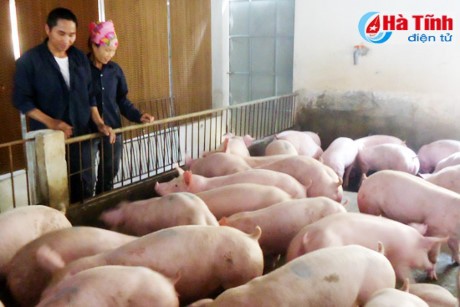(VOVworld) – Forming chains to increase competitiveness and add values to farm produce is helpful for the development of Vietnam’s agricultural sector. In Ha Tinh, a number of models of linkage between cooperatives have proven effective in reviving the sandy soil.
In the past, you had to travel 50 kilometers over rough roads to reach Ky Bac commune, a mountain village in Ky Anh district, Ha Tinh province. Harsh year-round weather conditions made it more difficult for the locals.
 |
| The project to grow vegetables and fruits on sandy soil has paved the way for cooperatives in Thach Ha to develop. (Photo: baohatinh.vn) |
But the Hoang Chau cooperative has changed things for the better. The cooperative’s director Tran Thi Chau says the initial six members offered a service transporting goods for Ky Bac villagers and their neighbors.
Chau says the cooperative operated sporadically, with no set schedule, and each member earned only 22 USD a month on average.
In 2012, thanks to the consultancy of the Ha Tinh Cooperative Alliance on production plans, loan support, and a link with the Ha Tinh Minerals and Trading Corporation (Mitraco), Hoang Chau cooperative began to raise pigs. This was Ha Tinh’s first pilot model in pig breeding. In the beginning seven members contributed a total of 36,000 USD. Now the cooperative’s capital has reached about 270,000 USD.
 |
| Mitraco kicks of the construction of a sika deer velvet processing plant in Ha Tinh province on October 4. (Photo: baomoi.com) |
Director told VOV: “all our input and output materials are guaranteed by Mitraco, who has also helped us to build breeding facilities. When the pigs are 20 days old, Mitraco buys them and distributes them to breeding farms. Under the model of linkage we have been given farming techniques and medicine and all our products have been guaranteed. We aren’t afraid of an epidemic anymore because we carefully clean and sanitize the pigsty.”
Deer are suited to the local natural conditions and return a good profit. Considered a hard currency earner, deer breeding is now pursued for antler velvet and meat. Phan Van Luat, chairman of a deer breeding and antler velvet cooperative, said: “in the past, traders used to lower the price of deer antler velvet. But now Son Lam villagers are glad because cooperatives are in charge of gathering and buying all products. In the future, with the advantages of hills and large fields of grass, cooperatives will continue to grow. Our problem is getting loans. We hope we will get some help in dealing with that issue.”
 |
| The linkage model of pig breeding run by Mai Xuan Hanh family from hamlet 2, Son Tho village, returns high profit. |
Those are just two of hundreds of linkage models that Ha Tinh has created, specializing in growing vegetables and fruits and cattle breeding. The highlight of Ha Tinh agricultural production is the chains that have been established in production and consumption. The province has identified its strongest products - pigs, cows, shrimp, deer, vegetables, and fruits, especially Phuc Trach pomelos. The Ha Tinh provincial Party Committee Secretary Le Dinh Son said its 54 cooperatives are linked with enterprises.
“For the current production model, farmers should enhance coordination; otherwise it will be difficult for them to apply high-tech and consume products. To get more investment, cooperatives should also network with enterprises,” according to Son.
Cooperatives, on one hand, link farmers and businesses and, on the other hand, control the production process and support farmers’ investment.
Le Duc Thinh, Deputy Director of the Economic Cooperation and Rural Development Department, says “when participating in the chains, cross checks are conducted via commitments or contracts, while members can help each other in investment attraction. It is also easier for members to borrow money from financial institutions.”